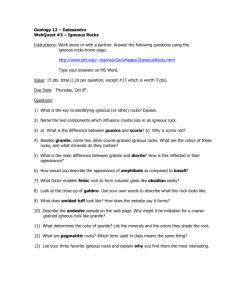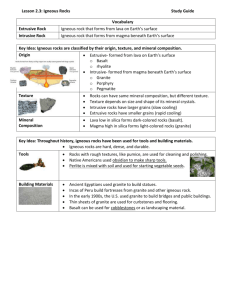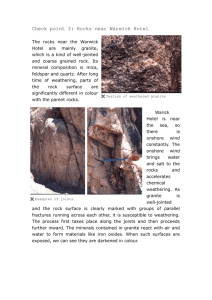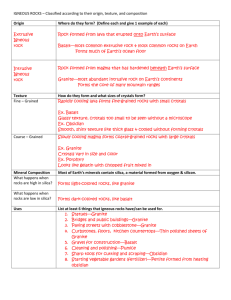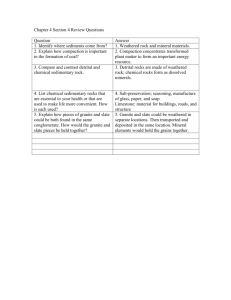Learning Goals Clocks
advertisement
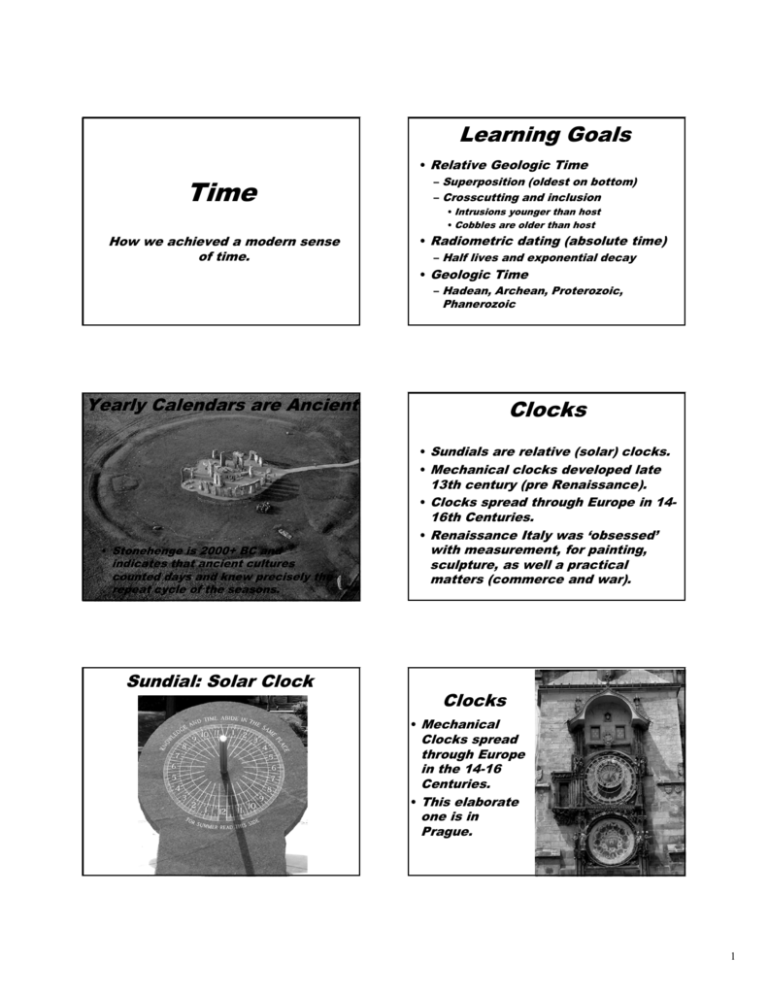
Learning Goals Time How we achieved a modern sense of time. • Relative Geologic Time – Superposition (oldest on bottom) – Crosscutting and inclusion • Intrusions younger than host • Cobbles are older than host • Radiometric dating (absolute time) – Half lives and exponential decay • Geologic Time – Hadean, Archean, Proterozoic, Phanerozoic Yearly Calendars are Ancient Clocks • Sundials are relative (solar) clocks. • Mechanical clocks developed late • Stonehenge is 2000+ BC and indicates that ancient cultures counted days and knew precisely the repeat cycle of the seasons. Sundial: Solar Clock 13th century (pre Renaissance). • Clocks spread through Europe in 1416th Centuries. • Renaissance Italy was ‘obsessed’ with measurement, for painting, sculpture, as well a practical matters (commerce and war). Clocks • Mechanical Clocks spread through Europe in the 14-16 Centuries. • This elaborate one is in Prague. 1 Deep Time (Clocks in the rocks) • Bishop Ussher 17th Cent. (biblical): 4004BC • Buffon 18th Cent. (Cooling of spheres): ~50000 Y • Hutton late 18th Cent. (Geological cycles): Infinite • Darwin late 19th Cent. (Biological changes): Billions • Kelvin late 19th C (Sun’s energy): 40 Million Max (Kelvin was wrong!) • Modern (Radiometric): 4.55 Billion Superposition: Oldest on bottom Relative Age of Rocks • Original Horizontality – Sediments were originally flat-lying • Superposition – The oldest ones are on the bottom • Cross-cutting – The disturbed (host) rocks are older than disturbing rocks Correlation of Layers • Physical Continuity – Horizontal tracing • Similarity of rock types and sequences • Correlation of Fossils – Faunal succession Crosscutting: Correlation of Layers Host rocks (red) are older than the intruding rocks (black). 2 Crosscutting Principle of Cross-cutting Relationships Grand Canyon Angular Unconformity, GCNP 3 Angular Unconformity, GCNP Angular Unconformity, GCNP Angular Unconformity, GCNP The Age of the Earth • Bishop Ussher 17th Cent. (biblical): 4004BC • Buffon 18th Cent. (Cooling of spheres): ~50000 Y • Hutton late 18th Cent. (Geological cycles): Infinite • Darwin late 19th Cent. (Biological changes): Billions • Kelvin late 19th C (Sun’s energy): 40 Million Max (He was wrong!) • Modern (Radiometric): 4.55 Billion Ice Ages Mammals and Flowering Plants Dinosaurs Fish Trilobites Time scale is NOT linear 4 Relative Age of Rocks • By the mid 19th century a relative time • • • • Event Sequence scale had been worked out for the sedimentary rocks of Europe (Phanerozoic). They lacked an absolute time scale. Kelvin and classical physicists advocated 40 million max. Darwin and evolutionary biologists advocated billions of years. Discovery of radioactivity at about 1900 confirmed billions. Event Sequence 1. Original horizontality 2. Superposition (oldest on the bottom) 3. Crosscutting (Intruding igneous rocks are younger than their hosts) Radiometric Dating: Establishing an absolute time scale • Minerals contain naturally radioactive elements – K, U, Th, Rb, Sm • These elements decay to stable daughter elements • When minerals crystallize from melt, they contain parent only. Radiometric Dating Example: 40K - 40Ar • A K-feldspar (KAlSi3O8) crystallizes in a granite and initially contains no Ar. • Natural K is 0.012% 40K • Atmospheric Ar has 3 stable isotopes – 36K, 38K, 40K – No 36K, or 38K in feldspar. • If we measure the concentration of daughter element in a mineral and we know the decay rate, we can calculate when the mineral crystallized. 5 Radiometric Dating Example: 40K - 40Ar • A K-feldspar (KAlSi3O8) crystallizes in • • • • a granite and initially contains no Ar. Natural K is 0.012% 40K 40K decays to 40Ar with a half-life of 1.31 x 109 years (1.3 billion years). If we measure the 40Ar content of the feldspar, we can get a crystallization date of the mineral. Isotope measurements are made with a mass spectrometer. Inclusion: Host rocks are younger than the included rocks (cobbles). Radiometric Dating • Igneous and metamorphic rocks can • • • • be dated directly by radiometric methods. Sediments cannot be dated directly. Igneous rock fragments in sediments can be dated. (Sed must be younger) Igneous rock intruding sediments can be dated. (sed must be older) 14C can be used to date organic matter less than ~50000 yrs old. Radiometric Dating • Igneous and metamorphic rocks can • • • • be dated directly by radiometric methods. Sediments cannot be dated directly. Igneous rock fragments in sediments can be dated. (Sed must be younger) Igneous rock intruding sediments can be dated. (sed must be older) 14C can be used to date organic matter less than ~50000 yrs old. Intrusion: Host rocks (red) are older than the intruding rocks (black). 14C system is different from other radiometric dating systems. • 14C in the atmosphere comes from 14N • Plants take 14C from atmosphere • 14C has half-life of 5730 years • There is no 14C in rocks. • 14C can be used to date plant and animal matter that is younger than about 50,000 years. 6 Exponential Decay Types of Radioactive Decay • Particle composed of: Mass# Atomic # Example • alpha 2 neutrons+ 4 2 U, Th, • beta• beta+ • gamma 2 protons electron positron photon nuclear reactions • neutron neutron Naturally Radioactive Isotopes • • • • • • Geologic Time Scale Period Began (My ago) Quaternary 0.01 Pleistocene 1.6 Pliocene 5.3 Miocene 23.7 Oligocene 36.6 Eocene 57.8 Paleocene 66.4 Cretaceous 144 Jurassic 208 Triassic 245 Permian 286 Pennsylvanian 320 Mississippian 360 -1 +1 0 1 0 40K 40K all 235U Naturally Radioactive Isotopes Parent • Eon Era • Phanerozoic Cenozoic • • Tertiary • • • • • Mesozoic • • • Paleozoic • • 0 0 0 Daughter Half life Decay 40K 40Ar 238U 206Pb + 8, 7, 6, - 87Rb 235U 232Th 14C 87Sr 207Pb 208Pb 14N 1.3 Gy 49 Gy 4.5 Gy 0.7 Gy 14 Gy 5700 y Geologic Time Scale • • • • • • • • • • • • Phanerozoic Cenozoic Mesozoic Paleozoic Permian Pennsylvanian Mississippian Devonian Silurian Ordovician Cambrian Proterozoic Archean Hadean 286 320 360 408 438 505 550 2500 4000 4550 7 Some Major Events • • • • • • • • • • • Latest warming 7000y Ice ages ~1.8 MY to 7000 years ago Dinosaur extinction 66 MY Dinosaurs ~245 MY Vertebrates ~400 MY Multi-cell life forms ~550 ‘Cambrian Explosion’ ‘Snowball earth’ 600 MY Free O2 ~ 2.5 GY (CH4 and NH3 decline) Single cell life forms ~3.7 GY Oceans: at least by 4.3 GY Accretion: 4.55 GY Tree of Life Ice Ages Mammals and Flowering Plants Dinosaurs Fish Trilobites Geologic Time Terms • • • • • • • • • • Hadean Archean Proterozoic Phanerozoic Paleozoic Mesozoic Cenozoic(Tertiary) Cambrian Unconformity Angular unconformity • • • • • Half-life Alpha particle Beta particle Gamma ray Neutron A conglomerate contains some granite cobbles. K-Ar date on the granite gives 180 MY. 8 A conglomerate contains some granite cobbles. K-Ar date on the granite gives 180 MY. It is only rarely possible to use radiometric methods to directly date sedimentary rocks. But igneous and metamorphic rocks can be dated directly. A conglomerate contains some granite cobbles. K-Ar date on the granite gives 180 MY. Host rocks (red) are older than the intruding rocks (black). • A. The conglomerate is older than 180 MY • B. The conglomerate is younger than 180 MY • C. The conglomerate is 6000 y old • D. No age inference can be made. A shale is intruded by a basalt dike that has an age of 1100 MY. Clicker A shale is intruded by a basalt dike that has an age of 1100 MY. • A. The shale is older than 1100 MY • B. The shale is younger than 1100 MY • C. The shale is less than 1 million years old. • D. No relative age inference can be made. 9 Exponential Decay Geologic Time Scale • Eon Era • Phanerozoic Cenozoic • • Tertiary • • • • • Mesozoic • • • Paleozoic • • The era of dinosaurs is subdivided into Triassic, Jurasssic, and Cretaceous. Together these are known as the: • A. Archean • B. Proterozoic • C. Paleozoic Period Began (My ago) Quaternary 0.01 Pleistocene 1.6 Pliocene 5.3 Miocene 23.7 Oligocene 36.6 Eocene 57.8 Paleocene 66.4 Cretaceous 144 Jurassic 208 Triassic 245 Permian 286 Pennsylvanian 320 Mississippian 360 Why can’t 14C be used to date limestones? • • • • • A. No carbon in limestone B. No 14C in limestone C. 14C half-life too long D. 14C half-life too short E. Daughter 14N not retained by limestone • D. Mesozoic • E. Cenozoic Half-lives: If the amount of radioactive isotope is ¼ the amount originally present, how many halflives have gone by? • • • • A. B. C. D. 1 2 3 4 Half-lives: If the amount of radioactive isotope is ¼ the amount originally present, how many halflives have gone by? • • • • A. B. C. D. 1 2 3 4 10 Event Sequence 1. The basaltic dike is older than the granite A. True B. False Event Sequence 2. The basaltic sill is older than the granite. A. True B. False Event Sequence Event Sequence 3. Sediment layer ‘a’ is older than the granite A. True B. False 4. Sediment layer ‘q’ is older than the granite A. True B. False 11
